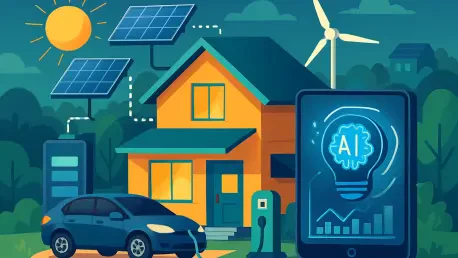In an era where technology seamlessly integrates into daily routines, artificial intelligence has transitioned from a futuristic concept to a household staple, powering everything from virtual assistants to smart thermostats. However, this convenience comes with a significant yet often overlooked drawback: a sharp increase in energy consumption. Reports indicate that AI-driven tools require up to ten times more power than traditional digital services, casting a spotlight on the financial and environmental ramifications. As smart homes proliferate across the globe, the energy burden tied to these innovations is becoming a pressing concern for households. This growing reliance on AI not only transforms lifestyles but also inflates electricity bills, prompting a deeper examination of how much power is being drawn behind the scenes. Understanding this hidden cost is crucial as society balances the benefits of cutting-edge technology with sustainable living.
1. Unveiling the Energy Impact of AI in Homes
The pervasive adoption of AI technologies in households marks a significant shift in how daily tasks are managed, from querying chatbots for quick answers to automating home systems for efficiency. Yet, this technological leap forward is accompanied by a substantial rise in energy usage that many users fail to notice. Scientific studies have highlighted that AI applications consume dramatically more electricity than conventional search engines, often multiplying the power draw by a factor of ten. This surge is not just a technical statistic; it translates into higher utility bills for families already grappling with rising living costs. As smart devices become integral to modern living, the cumulative effect of their energy demands poses questions about long-term affordability. Governments and energy providers are beginning to take note, but the responsibility often falls on consumers to navigate this new landscape of tech-driven power consumption.
Beyond the immediate financial impact, the environmental consequences of increased energy use due to AI cannot be ignored. The carbon footprint associated with powering these advanced systems adds another layer of complexity to their widespread adoption. Many countries are still reliant on non-renewable energy sources, meaning that the electricity fueling smart homes often contributes to greenhouse gas emissions. This reality underscores the urgency of addressing how AI integration affects both household budgets and global sustainability goals. While innovations promise convenience, they also demand a reevaluation of energy policies and consumer habits to mitigate their broader impact. The intersection of technology and ecology is becoming a critical area of focus as more homes embrace digital solutions without fully grasping the power they require.
2. Insights from the Smart Home Energy Burden Index
A comprehensive analysis recently released through the Smart Home Energy Burden Index offers a detailed look at how AI and smart devices are influencing electricity usage across 21 countries. This index evaluates multiple factors, including the frequency of AI-related searches, the prevalence of smart technology in homes, overall electricity consumption, and the associated costs. By compiling these metrics, a clearer picture emerges of where the energy footprint of AI is most pronounced on a global scale. The findings reveal stark disparities in how different nations are affected, with some facing significantly higher burdens due to both usage patterns and pricing structures. This data serves as a vital tool for understanding the intersection of technology adoption and energy economics in the modern era.
The methodology behind the index underscores the complexity of measuring AI’s energy impact, as it accounts for both direct usage through devices and indirect engagement via online platforms. High-ranking countries demonstrate a strong correlation between tech enthusiasm and elevated power consumption, often exacerbated by local electricity tariffs. For households in these regions, the cost of staying connected through smart solutions can be a substantial portion of monthly expenses. This index not only highlights the financial strain but also prompts discussions on how energy infrastructure must evolve to support growing digital demands. As more data becomes available, policymakers and energy sectors may use such insights to devise strategies that balance technological advancement with economic and environmental considerations.
3. Leading Nations in AI-Driven Energy Consumption
Among the top-ranked countries in the Smart Home Energy Burden Index, Portugal stands out with a score of 68.19 out of 100, driven by an extraordinary volume of AI tool searches—approximately 4,705 per 1,000 people. With household energy consumption exceeding 5,100 kWh annually and electricity priced at around $0.36 AUD per kWh, the financial impact is considerable for residents. Following closely, Luxembourg secures second place due to its high AI interest and an impressive 90% reliance on renewable energy, though its per capita usage of 11,168 kWh remains a significant factor. Australia ranks third, reflecting a robust appetite for smart home devices and AI tools, with nearly 9,832 kWh used yearly per household. Other notable entries include Spain, the Netherlands, Denmark, the United Kingdom, Sweden, Austria, and Switzerland, each grappling with unique combinations of high costs, usage, and tech adoption that inflate their energy scores.
Delving deeper into the list, specific challenges emerge for each nation, such as Denmark and the United Kingdom facing some of the highest electricity rates at $0.55 AUD and $0.62 AUD per kWh, respectively. These steep prices amplify the burden of AI and smart device usage, even in regions with strong renewable energy profiles. Sweden, with over 12,000 kWh per capita annually, showcases the highest individual consumption in the top ten, though lower tariffs provide some relief. The diversity among these leading nations illustrates how cultural enthusiasm for technology, combined with economic and energy policy factors, shapes the overall impact on household budgets. This global snapshot reveals that while AI offers transformative potential, it also demands a careful assessment of resource allocation to prevent unsustainable cost escalations.
4. Nations with Minimal AI Energy Footprints
In contrast to the high-ranking countries, some nations exhibit a remarkably low energy burden tied to AI and smart technology adoption. Czechia leads this group with the least impact, recording just 1,465 AI searches per 1,000 individuals and minimal engagement with smart devices, resulting in a lighter electricity load for households. Other countries with lower scores include Italy at 38.12, Germany at 38.58, and Poland at 39.69, where limited interest in AI tools and smart gadgets keeps consumption in check. Surprisingly, the United States ranks only 17th with a score of 40.28, despite its leadership in AI innovation, largely due to lower search volumes for AI and more affordable electricity rates compared to European counterparts. These findings highlight how varied adoption rates influence energy outcomes.
The lower energy burden in these countries often stems from a combination of cultural hesitance toward rapid tech integration and economic factors that deter widespread use of power-intensive devices. For instance, in regions like Czechia and Poland, traditional methods of managing households still prevail over smart alternatives, reducing overall electricity demands. Meanwhile, Germany’s moderate ranking reflects a balanced approach to technology adoption, tempered by robust energy efficiency regulations that curb excessive usage. The United States presents a unique case where innovation hubs exist alongside vast areas with limited AI engagement, diluting national averages. These disparities suggest that energy burdens are not solely a function of technological capability but also of societal and policy-driven choices that shape consumption patterns.
5. Specific Challenges Facing Australian Households
Australia’s position as the third-highest in the Smart Home Energy Burden Index signals a profound engagement with both AI tools and smart home technologies, placing considerable strain on household energy resources. With annual consumption nearing 9,832 kWh per household, the enthusiasm for cutting-edge solutions is evident, but it comes at a steep cost. Electricity bills are becoming a growing concern for many families, especially as power prices remain a contentious issue nationwide. This reliance on digital conveniences raises critical questions about how sustainable such trends are in the long term, particularly when balancing household budgets against the allure of innovation. The data underscores a need for strategic interventions to manage this escalating demand.
Moreover, while Australia is making strides in expanding renewable energy capacity, the current dependency on AI-driven systems suggests that immediate solutions are necessary to address energy costs. Environmental implications also loom large, as increased consumption often correlates with higher carbon emissions unless offset by green energy sources. For Australian households, the challenge lies in maintaining access to technological advancements without sacrificing financial stability or ecological responsibility. Policymakers and energy providers may need to collaborate on initiatives that promote energy-efficient technologies or offer incentives for reducing usage. As the nation navigates this intersection of tech adoption and sustainability, consumer awareness will play a pivotal role in shaping future outcomes.
6. Practical Strategies for Reducing Energy Costs
For households looking to mitigate the energy burden imposed by AI and smart devices, several actionable steps can make a tangible difference in managing electricity costs. One effective approach is to explore different energy providers and compare plans, as switching to a more competitive rate can save hundreds of dollars annually. Many regions offer tools and services that simplify this process, allowing consumers to identify plans better suited to their usage patterns. This financial strategy can be particularly impactful for families in high-cost areas where even small reductions in rates yield significant savings. Taking control of energy expenses through informed choices empowers households to offset the hidden costs of technology.
Additionally, optimizing the use of smart devices themselves presents another avenue for reducing power draw without sacrificing convenience. Enabling energy-saving modes on devices and unplugging gadgets when not in use can curb unnecessary consumption. Furthermore, leveraging smart meters to monitor real-time electricity usage helps identify wasteful patterns and encourages more mindful habits. These meters provide detailed insights into when and how energy is consumed, enabling targeted adjustments to daily routines. By combining these practical measures with a proactive approach to energy management, households can better navigate the challenges posed by the increasing integration of AI technologies. Small changes in behavior and setup can collectively contribute to a more sustainable and cost-effective home environment.
7. Reflecting on a Power-Hungry Tech Landscape
Looking back, the integration of AI and smart technologies into everyday life has redefined how tasks are approached, from automating mundane chores to enhancing productivity through intelligent systems. However, this transformation also brought to light a significant escalation in energy consumption that many had not anticipated. Australian households, in particular, grappled with the dual challenge of embracing these innovations while contending with the resultant spike in utility bills. Each interaction with a smart device or AI tool quietly drew more power from the grid, accumulating costs that often went unnoticed until the monthly statement arrived. This realization prompted a broader conversation about the true price of technological convenience.
Moving forward, the focus shifts toward actionable solutions and heightened awareness to address this energy conundrum. Households are encouraged to adopt energy-efficient practices and explore cost-saving opportunities with providers to lessen the financial strain. Simultaneously, the push for renewable energy sources gains momentum as a means to offset the environmental impact of increased consumption. As technology continues to evolve, the emphasis on balancing its benefits with sustainable energy use becomes paramount. Future innovations are expected to prioritize efficiency, ensuring that the digital age does not come at an unsustainable cost to both wallets and the planet.









